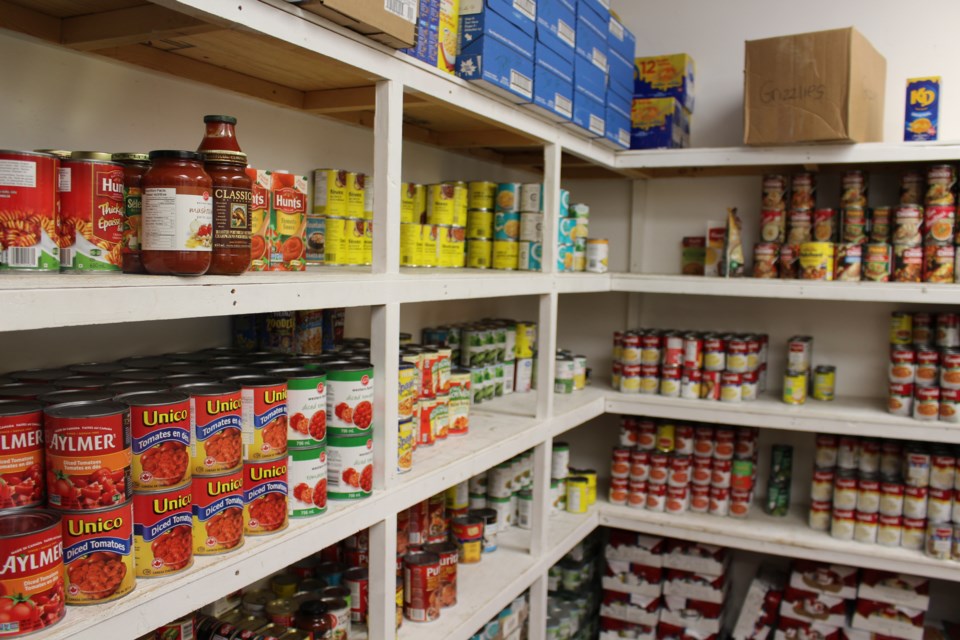BONNYVILLE – As the holiday season approaches demand for services provided by Alberta food banks continues to rise. Fortunately, in the Town of Bonnyville so too does the spirit of charitability.
“We are so fortunate here in Bonnyville because the community is great,” says Janet Gobert, the community initiatives coordinator at the Bonnyville Friendship Centre. “The businesses and community always support us.”
On average the Bonnyville Food Bank, which operates out of the Bonnyville Friendship Centre, serves roughly 500 families and individuals per month.
Pauline Mawer, an executive assistant with the centre tells Lakeland This Week that since the pandemic hit, they have seen an increase is those accessing the food bank; however, the demand has been met with increased support and donations from the community.
From the end of September through October, the food bank received over a thousand pounds of food from various business and schools in the area.
A few of the donations recently received by the centre, for example, came from students and staff from École des Beaux-Lacs, Bonnyville Centralized High School, Dr. Bernard Brosseau School, Duclos School and École Notre Dame High School.
The 2021 HungerCount Report released by Food Banks Canada at the end of October showed that in March 2021, over 116,000 Albertans had visited a food bank. This was a 29.6 per cent increase from pre-pandemic levels reported in 2019.
According to findings outlined in the report, one in eight Canadians access a community food program, such as food banks and hot meal programs. In rural Alberta, roughly 30 per cent of food bank users are seniors or persons with a disability.
At the Bonnyville Food Bank, food items provided are based on family size and can be accessed once per month.
Gobert says the hampers provided by the Bonnyville Food Bank are quite large compared to what other food banks are able to supply. The centre’s staff members also do their best to include snacks and easy to put together lunch items for families with school age children.
Those eligible for the food bank must live in the Town of Bonnyville or reside within the MD of Bonnyville, which includes Ardmore, Fort Kent, La Corey, Iron River, Muriel Lake, Moose Lake and Glendon.
More than just a food bank
The Friendship Centre’s Community Kitchen also serves hot lunches from Monday to Thursday, 11:30 a.m. to 12:30.
Prior to the pandemic, individuals and families dropping in at the centre for a warm meal were able to access the downstairs dining area. In order to continue serving the community, staff members now hand meals out at the front desk to anyone wanting a hot lunch.
Recently reopened is the Friendship Centre’s Clothing Depot, where families and individuals can pick out a wide range of items from books to boots, baby clothes to men’s winter jackets, all free of charge.
“Usually, I allow a bag a week, but right now they can just take whatever they want. Right now, we have men's winter stuff coming, we've got everything, but this will go fast,” says Mawer, adding since the Clothing Depot has been closed to the public, they have continued to receive donations from the community.
“Once people know that we have reopened, what usually comes in usually just goes right back out.”
Increased demand at food banks seen across Alberta
Although the increases in food bank usage in Bonnyville has been manageable, across the province other food banks are reporting a surge in demand.
In a statement, Richard Matern, the director of research for Food Banks Canada stated, “The 2021 HungerCount data shows early in the pandemic, government supports helped flatten demand at Canada’s food banks, but in recent months, visits are beginning to surge with one-in-seven food banks experiencing a doubling of demand.”
Factors attributed to the rise in food banks and their services are rising food and housing costs, pandemic-related job loss and unemployment.
Arianna Scott, the interim CEO Food Banks Alberta says, “It’s staggering to see these numbers in Alberta, but not surprising with how hard hit the province was largely due to the pandemic.”
The HungerCount reports that Canadians on fixed incomes, such as seniors and those on disability benefits make up 27 per cent of food bank visits across the country, reflecting that the trend in access persists across provincial borders.
“We have heard from our member food banks that an increasing number of seniors and individuals with disabilities are accessing food banks more than ever before – particularly in rural areas, who are seeing over 30 per cent of total users falling into this group,” Scott points out.
“Benefits that were available to the rest of the country, like CERB that made such a difference in keeping households afloat just weren’t available to seniors and those with disabilities. The fact is, food costs keep rising, and so do the basics like rent and transportation. They just can’t afford to do it all.”
Scott adds they are seeing a silver lining, “If there’s one good thing that’s come out of the pandemic, it’s the generosity of our communities. The retailers, the individuals and communities – they’ve really stepped up and continued to support us.”


